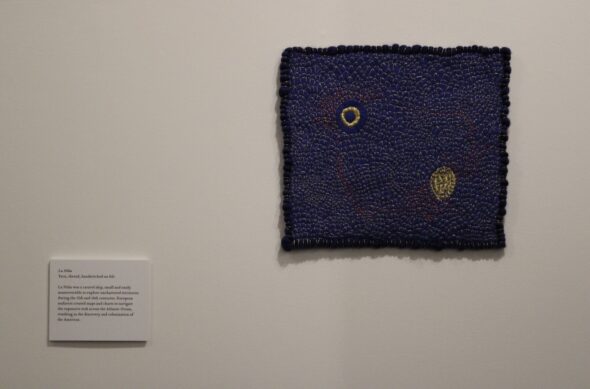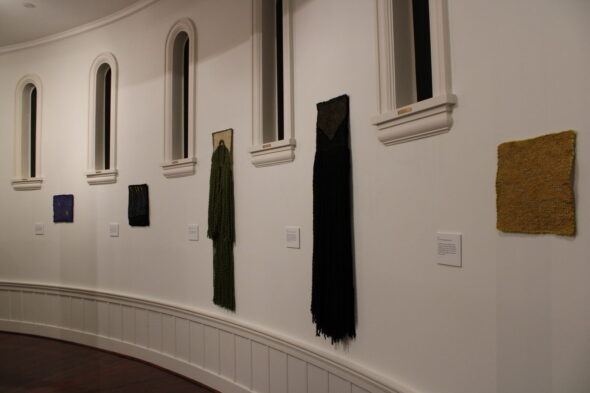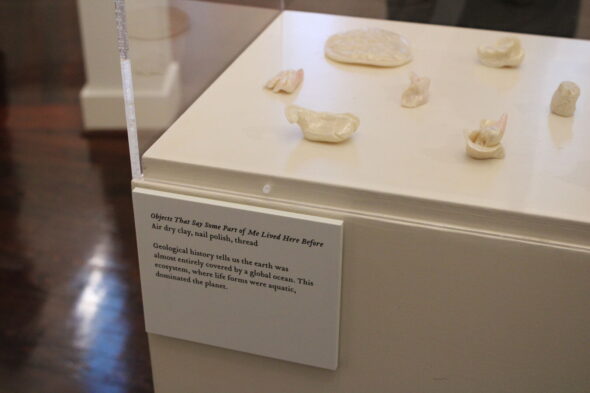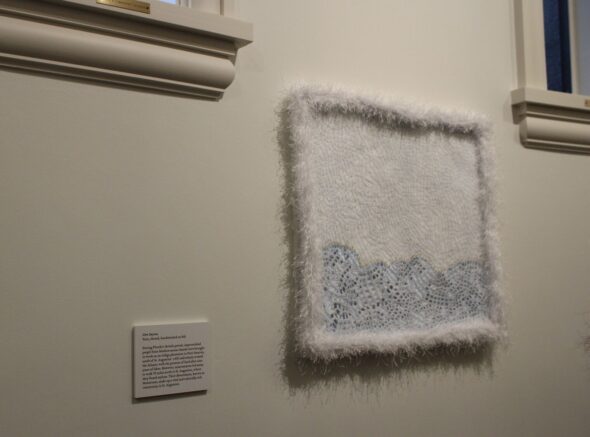By Joules Margot
Laura Mongiovi’s work starts with a time and a place. The history of a location is pivotal to Mongiovi’s work. Her latest exhibit, Empire, which focuses on textiles, sculpture, and drawing, aims to uncover the structures of power and beauty in a contemporary and historical context.
“You can’t understand where you are in present time unless you understand or are aware … of what happened before you,” Mongiovi said. “Who walked in this place? Who lived here before you? How did this place come to be? All of that influences how we interpret and react in present time.”

Currently a Professor of Art at Flagler College, Mongiovi has been featured in Surface Design Journal and New American Paintings. Her work has also been installed in numerous institutions nationally.
On Friday, March 7, in the Lightner Museum, Empire debuted. During its opening reception, readings were preformed by Ben Atkinson, Kim Bradley, and Jeanette Vigilotti, all of whom are faculty members of Flagler College.

Along the walls of the East Room Gallery hung Mongiovi’s pieces: textiles, weavings, clay sculptures and mirrors. The pieces varied in color, dimension, texture and inspiration. Some pieces boasted descriptive placards featuring anecdotes of colonization and others described features of power through apparel.
Empire, whose featured piece is La Niña, focuses on the structures of power and beauty. The gallery highlights numerous perspectives on colonization, particularly in the Americas, from the explorers who sought to uncover new lands to those who suffered enslavement at the hands of imperialists.

“Empire is the body of work that is just coming from different stories,” Mongiovi said.
Mongiovi’s previous exhibits not only reflect this sentiment, but they are intended to co-exist with her more recent work such as Empire. Featured in St. Augustine’s Tovar House, Exposing History: Color, Taste and Textiles is representative of the lineage of plantations in Florida and the impact of both Spanish and British colonization upon indigenous peoples. The Grass Is Blue, installed in the Anne Wright Wilson Gallery at Georgetown College in Kentucky, aims to “raise awareness of past events, to reflect upon the span of humanity and culture within the region, and to generate current feelings of empathy and community.”

A trend throughout the exhibit is the highlighting of ways in which wealth was displayed by those in higher statuses. Desire, a stitched piece within the gallery, is reflective of this by describing the inequality between the statuses of Ancient Rome where only the aristocratic class could wear pearls. Similarly, Empire, the title piece, emulates the phenomenon of garments used to portray wealth and power through its gold thread.
Subconsciously, an additional theme of Empire is the environmentally conscious urge to acknowledge the earth’s existence prior to humanity. In the center of the exhibit was a glass-covered display case of clay shells and oceanic organisms titled Objects That Say Some Part of Me Lived Here Before. This piece recognizes that “the earth was almost entirely covered by a global ocean” and emphasizes the existence of aquatic beings where humans now roam. The prose of Ben Atkinson literally reflects this theme in mirrors which frame the lines: “Primeval secrets may return when we learn to listen to the earth again.”

A uniting element of the galleries is their expression of untold history. On the topic of what inspires her work, Mongiovi said, “A part of it came from indigenous people, or parts of history, not being acknowledged.”
Awareness of the connections between people through multiple facets is a driving force of Mongiovi’s work. It is heavily influenced by “that idea of understand where you came from, and what the people before you, whether they’re related to you or not, endured.”

This concept, along with Mongiovi’s appreciation for textiles, arise from her heritage. In particular, from her grandmothers whom, on both sides of her family, were seamstresses from Sicily.
“I have super fond memories of being in my grandmother’s sewing room,” Mongiovi said. “They never learned English because they just lived in the Italian neighborhood, so we communicated a lot through objects. So, I have very fond memories of collecting threats and fabrics and playing with all those sewing tools. I can remember the light, how it came in the window and her clothes, ‘cause she made clothes and she tailored clothes.”

Though Mongiovi’s work does not focus solely on textiles, she does find stitching to be meditative.
“I find great…solace, or comfort, in that process of stitching. It’s repetitive.” Mongiovi said. “Textiles, fabric, we’re wrapped in it when we’re born. We’re wrapped in it when we die. We spend our entire lives touching textiles, so it’s a material that resonates with people in so many ways.”
Empire is being featured in the Lightner Museum’s East Room Gallery from March 7th until May 18th. To explore more of Laura Mongiovi’s gallery work, visit lauramongiovi.com.



Be the first to comment on "Stitching Together Life and Location: Laura Mongiovi’s ‘Empire’"